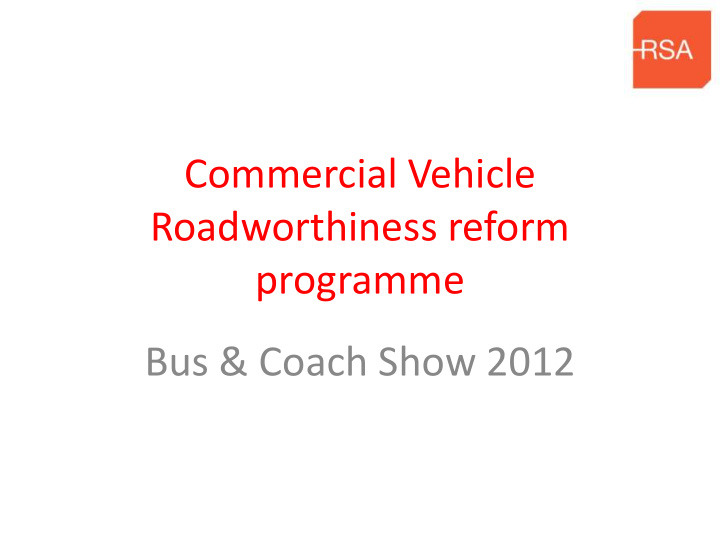



Commercial Vehicle Roadworthiness reform programme Bus & Coach Show 2012
Objectives of the Commercial Vehicle Roadworthiness programme Reforms to commercial vehicle roadworthiness testing, operator compliance and enforcement. Aims to: develop a leading edge commercial vehicle safety regime build upon the experience of other European jurisdictions use technology to enhance the ‘joined up’ aspects of government contribute to Ireland’s improving road safety record over the next 10 years and beyond. 2
The need for reform is clear Current roadworthiness standards are unacceptable: 2011: Roadworthiness checks were completed on 4,919 vehicles. Of these, 2,312 (48%) of vehicles had defects with 32% having defects serious enough to warrant immediate action, such as impoundment, repair on site or a new test. 2011: VOSA statistics from Great Britain enforcement inspections show even higher rates of non-compliance with 6,975 Irish registered vehicles stopped during 2011. Of these, 3,988 had infringements that resulted in immediate or delayed prohibitions (representing 57%). Improved road safety: reducing deaths and injuries from road traffic accidents involving commercial vehicles. Reduced costs to the economy: during 2010 An Garda Siochana and the RSA estimate that collisions cost the State € 853 million. Current testing compliance is unacceptable: Of 1,000 randomly sampled vehicles 5 years old, only 70% of annual tests were conducted (i.e. 3,500 out of 5,000). 3
What are the benefits for Operators? Enhancing fair market competition: Enforcement efforts will be targeted towards those who choose not to properly maintain & test their fleet annually Applies to all commercial vehicles operating on Ireland’s roads (licensed and non licensed) Introduction of an escalating range of sanctions Business efficiencies: No need to visit the Motor Tax Office for the purpose of collecting the CRW (will be dispatched by post automatically following the CVT) Enhanced vehicle roadworthiness reduces breakdowns and improves fuel efficiency Commercial benefits: Enhanced reputation nationally and internationally Evidence of compliance of roadworthiness can be used to commercial advantage 4
It is your responsibility to keep your vehicle in a roadworthy condition at all times Key obligations are simple: 1. Test your vehicle annually 2. Keep your vehicle in safe order and well maintained 3. Make an on-line self-declaration to the RSA: – Fleet details – Commit to ongoing safety inspections and maintenance – Commit to record keeping 5
A balanced approach to driving improvements Escalation process in terms of enforcement: Focus on education & awareness initially Issues dealt with on a case by case basis; Important obligations required of operators, drivers and test centres 6
What will change for commercial vehicle operators and drivers? The CRW will now include an insert for the windscreen Following the Annual Vehicle Test, the CRW will be dispatched by post (eliminating the need for the second visit to the Motor Tax office for that purpose) There will be a single fee (incorporating the test, the CRW and the road safety levy) Enforcement will be increased: Roadside Checks (bi-lateral enforcement: An Garda Siochana and the RSA) Risk-based targeting Visits to operator premises for the purposes of assessing roadworthiness compliance Introduction of a new range of remedies to address non- compliance: may be applicable to the driver, the operator or the registered owner. 7
Other features of the reforms A new legislative framework has been introduced The Road Safety Authority (Commercial Vehicle Roadworthiness) Act 2012 The national network of commercial vehicle test centres will be supervised by the RSA, not the Local Authorities Vehicle tester training has been reformed Introduction of risk-based indicators – ‘Commercial Vehicle Operator Risk Indicator’ (CVORI) Initially HGV and PSV only Based on evidence (self-declaration, test history, encounter history, premises checks) Time-bound (rolling 3 year indicator score) Risk indicators increase to reflect non-compliances and decrease to reflect good performance Industry sector element to be included A tool to support targeted action e.g. education & awareness, roadside enforcement 8
2013 Communications with Operators First half of the year: raising awareness Leaflets and posters Media Regional meetings Information available on the RSA web-site First half of the year: operator premises visits to commence Later in 2013: Introduction of the operator self-declaration process Introduction of centrally dispatched CRWs 9
Recommend
More recommend